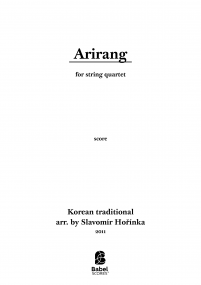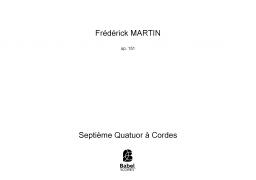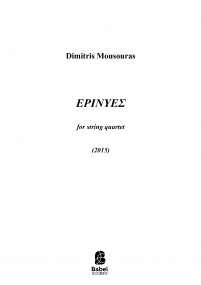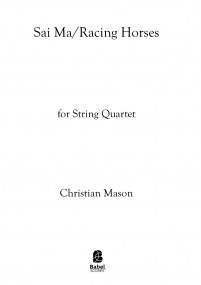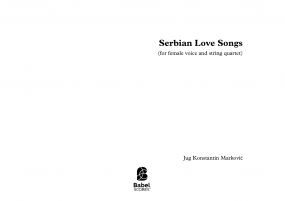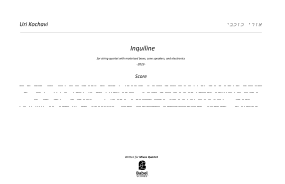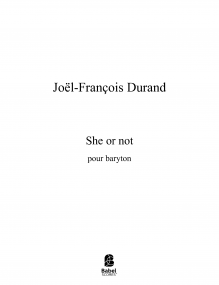Recherche avancée
String Quartet #1
#64 (2002)
15,45 €
Version numérique (+0,00 €) à télécharger
Version papier (+20,30 € impression et livraison ). Colissimo7-14 days aprox.
Chez BabelScores, quand vous achetez une partition, vous pouvez ensuite contacter directement le compositeur ici même !
Caractéristiques
Region
Europe
Estimated Duration
41 - 60min
Date
2002
ISMN : 979-0-2325-1200-6
Notes sur cette pièce
The influence of nonlinear phenomena and the scaling of multidimensional phase space served as generating principles for musical composition in this First String Quartet. As will be shown, two broad applications seem to have had a particularly robust potential for musical expression. The first involves the use of non-linear dynamics to structure large-scale formal development, while the second directly effects local sound production and gesture.
In the early 1980's, theories of nonlinearity were beginning to be applied to complex musical signals that led some to reconceptualize their understanding of the elements involved in the production of sound. For some, this led to the use of multidimensionality resulting in extra-complex musical sonorities. Most often, this increased awareness has been applied in computer musical contexts. However, as acousticians, programmers, composers and performers had begun to systematically look into the tiny bits of sound, they found that it was possible to pull apart the texture of instrumental and (less often) vocal production. One of the pragmatic ways this was and is done is to look at the elements involved in the production of a sound and to explicitly change certain variables one by one while keeping the others constant.
This String Quartet #1 is involved with multidimensional networks whose internal variables are shifted within a scalable environment. My use of the term scalable suggests that a variable is assigned a minimal and maximal value. Then between these extremes, more or less discrete values are inserted, so that a sequence of linear steps from low to high, slow to fast, etc. is developed. The value of scaling these parameters affects global compositional ratios of novelty versus redundancy. Significantly, this suggests that the logical procedures of composed sound may stretch across 8 to 10 dimensions, rather than the usual 2 (pitch and rhythm). Then in certain cases, as the parameter space is filled with an increased activity of non-idiomatic behavior, bifurcations may appear to push the output into nonlinear phenomena appearing as unexpected, transient or extra-complex musical sonorities.
Ajouter à une playlist
- Identifiez-vous pour créer une liste
The influence of nonlinear phenomena and the scaling of multidimensional phase space served as generating principles for musical composition in this First String Quartet. As will be shown, two broad applications seem to have had a particularly robust potential for musical expression. The first involves the use of non-linear dynamics to structure large-scale formal development, while the second directly effects local sound production and gesture.
In the early 1980's, theories of nonlinearity were beginning to be applied to complex musical signals that led some to reconceptualize their understanding of the elements involved in the production of sound. For some, this led to the use of multidimensionality resulting in extra-complex musical sonorities. Most often, this increased awareness has been applied in computer musical contexts. However, as acousticians, programmers, composers and performers had begun to systematically look into the tiny bits of sound, they found that it was possible to pull apart the texture of instrumental and (less often) vocal production. One of the pragmatic ways this was and is done is to look at the elements involved in the production of a sound and to explicitly change certain variables one by one while keeping the others constant.
This String Quartet #1 is involved with multidimensional networks whose internal variables are shifted within a scalable environment. My use of the term scalable suggests that a variable is assigned a minimal and maximal value. Then between these extremes, more or less discrete values are inserted, so that a sequence of linear steps from low to high, slow to fast, etc. is developed. The value of scaling these parameters affects global compositional ratios of novelty versus redundancy. Significantly, this suggests that the logical procedures of composed sound may stretch across 8 to 10 dimensions, rather than the usual 2 (pitch and rhythm). Then in certain cases, as the parameter space is filled with an increased activity of non-idiomatic behavior, bifurcations may appear to push the output into nonlinear phenomena appearing as unexpected, transient or extra-complex musical sonorities.
Instrumentation
Violin (2)|Viola |Cello
Recording
concert recording by Kairos String Quartet
Score Details
Format - A4 / US Letter
Pages - 148
Pages - 148





